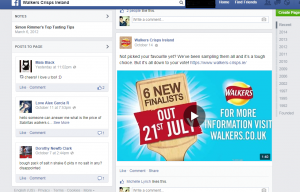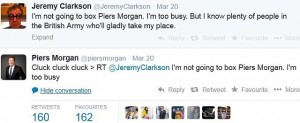The world of the social media hashtag is a complicated one. Often overused by users, the hashtag was originally designed to help consumers identify their topic of interest by keyword search. However, in a plight of excitement, consumers have gathered a stranglehold over brands as they struggle to rise above social media hijackers. Following some of the webs hashtag disasters – here’s a list on some of the dos and don’ts to creating your hashtag campaign.
(Source: Visually, 2013)
1. Know what you want to use the hashtag for!
Thousands of hashtags are posted each day and while the vast majority fail to take off, a small number will triumph within the mass-media. While it’s unlikely you’ll emerge as the latter, take the time to ask yourself – what specifically do you want to use your hashtag for?
One in five consumers believe that hashtags are useful for finding information on brands and products (RadiumOne, 2013). This comes after at Radium One survey which reveals the high expectations that come with brands hashtags. Unsurprisingly, the data also found that people were more inclined to share hashtags if it meant they were awarded with discounts.
If advertisers awarded discounts for sharing product-based hashtags I would:
(Source: RadiumOne, 2013)
With some of this data in mind, brainstorm some ideas. How are you going to get people sharing you hashtag? Depending on your offerings you may want to offer discounts if it’s financially and logistically feasible, or you may want to simply create buzz around a certain event. It’s not essential that you absorb yourself within your sales funnel, but do show that you are human. Hashtags are all about being fun and innovative and social media is the perfect place to do just that.
Walker’s #dousaflavour competition is a fantastic example of using digital crowdsourcing to get ideas on new product offerings. Incentivising users with a one million pound prize for the winning favour, users were encouraged to post their ideas on Facebook.
(Source: Digital & Contemporary Marketing Practices, 2014)
The campaign reinvigorated the brand and united consumers in their masses which created a widely successful hashtag campaign.
2. “Don’t” use the hashtag frivolously (overuse of the hashtag)
This one is obvious. Using hashtags excessively alienates the user. In fact research from Socialbakers reveals that the more hashtags brands use on their Facebook page, the less engagement it receives (Socialbakers, 2014).
(Source: Socialbakers, 2014)
Not only does extreme use of the hashtag depress overall social interactions, but it looks rather amateurish when your #hashtag #is #used #after #every #word. The solution is really quite simple; stick to the basics and ensure you don’t get too animated with your campaign. Any more than three hashtags, then there’s a chance you might be dispensing spam.
3. Make your hashtag short
Hashtags (in most cases) should be short and sweet. Remember you only have 140 characters to leave an impression on users, which shouldn’t be exhausted with a long winded and subsequently hard to find hashtag. Also, the longer the hashtag, the easier it is to misspell. You want to make yourself as visible as possibly, so coming up with something that’s creative and which doesn’t already exist gives you the best chances to be seen.
Quick Tip:
Use the limited character space to your advantage. Short-form and visual content has become a staple of the modern smartphone user with almost 30% of phone time being spent on a social media apps (Nielsen, 2014). Having your hashtag associated with pictures, videos, vines, infographics and Pinterest’s is an effective way of making your hashtag memorable and, in turn sharable.
4. Ally with other hashtagers
You can’t expect your hashtag to be an overnight sensation without embracing the social community. You’ll be making no friends If you’re feed is nothing but links to your own work. Ensure you retweet or share in the content of other brands. You’ll not only further your credibility amongst the community, but it’s also central to the experience of the platform (Jansen, Zhang, Sobel, & Chowdury, 2009).
Self-promotion is fine, but showing basic Twitter etiquette is an essentialist ingredient into cooking up your perfect campaign. Don’t be too scared to piggyback onto some of your affiliates or related topics. This will only leave a paper trail of your activity and, in effect reminds users of your brand. Furthermore, you might be surprised to find how often the favour is returned by other users – you could even be lucky enough to get a nod (or insult) from a high profile celebrity…
(Source: Daily Mail, 2014)
5. Promote your hashtag
While your hashtag may only feature on one platform, it’s important that you promote it in the same way you’d do a product. Integrating the hashtag with your content; any blogs, videos, infographics, quizzes, social media and of course your website will assimilate brand awareness across all virtues of the brand.
This doesn’t just have to be online; any forms of print will also do fine, as will emails, outdoor advertising, radio and so on.
Ask of your audience to “get involved” or “join in the discussion”. If you’re a SME the likes are you’ll struggle to get a meaningful gauge on your audience. This makes promoting your hashtag a requirement before launching your campaign
6. Build relationships with some of your brands biggest advocates
Now this could be the provisional title for my next post. Your followers, subscribers or friends are you biggest asset in the world of social media and it’s important that they feel just as noticed as you do. Too many social media campaigns function as lifeless entities – don’t let that be you – reach out to your fans and open a dialogue.
Coming across too preachy or sales orientated can be infuriating as a consumer, and don’t think for a second they won’t hesitate on turning their backs if they don’t like what you’re posting. Making it about the customer and not the product is your avenue into engagement. Using hashtags to form communal bonds fosters greater relationships and can positively alter perceptions of the brand (Forbes, 2012).
Remaining active also allows you to gain feedback, understand how your audience is motivated and what key characteristics you can hone in on. Tracking users of your hashtag can be beneficial for gathering a database of those who might be receptive to future brand messages, or could be targeted as a potential brand advocates (Econsultancy, 2013). To identify an advocate you must fully immerse yourself in the community and interact with those which matter most, since those who exhibit trust, empowerment and emotional bonding behaviours are more likely to remain loyal to the brand (Brodie, et al., 2010)
7. Be careful what you wish for…
Twitterers, Tweeters or “Tweeps” as they’ve been called, are unpredictable creatures. The last thing you want is your event/product/campaign backfiring due to an unforeseen miscalculation of your audience and/or campaign.
What do I mean by this? Well hashtag campaigns are notorious for failure just as much as they’re famous for success. For example there are 651 million people on Twitter, accessed majorly by consumers. More often than not, hijackers take centre stage on social media and can reduce your campaigns to manipulative target practise.
Here is an example of the unfortunately tagged #Susanalbumparty which was created in a bid to promote singer Susan Boyle’s new album:
(Source: Digital Spy, 2012)
While this was mainly a typo/PR malfunction, McDonalds received a wave of abuse after launching its #McDStories campaign
(Source: Econsultancy: 2013)
Of course the last thing you want is to fall victim to similar online ridicule. Stains proposes that the best pan of action is to come up with an acronym for your hashtag and end it with a number to ensure the internet isn’t trolled (Econsultancy, 2013; RADIUMONE, 2013).
However, there is no real way of preparing yourself for internet hijackers since you can’t own your Tweets (Mashable, 2013). The most important thing is to know your audience and to anticipate their behaviour. If you fear the worst for your new excellent campaign idea, you probably shouldn’t go ahead with it.
References
Brodie, R., Ilic, A., Juric, B. & Hollebeek, L., 2010. Consumer engagement in a virtual brand community: An exploratory analysis. Journal of Business Research, Vol 66(Issue 1), pp. 105-114.
Daily Mail, 2014. ‘Cluck, cluck, cluck’: Piers Morgan calls Jeremy Clarkson a chicken for refusing to fight him in boxing ring for £100,000 in latest round of long-running feuds. [Online]
Available at: http://www.dailymail.co.uk/news/article-2586867/Cluck-cluck-cluck-Piers-Morgan-calls-Jeremy-Clarkson-chicken-refusing-fight-boxing-ring-latest-round-long-running-feuds.html
[Accessed 18 April 2015].
Digital & Contemporary Marketing Practices, 2014. ‘Do Us a Flavour!’. [Online]
Available at: https://dcmpb00052923.wordpress.com/2014/10/20/do-us-a-flavour/
[Accessed 18 April 2015].
Digital Spy, 2012. Susan Boyle’s ‘susanalbumparty’ hashtag provides mirth on Twitter. [Online]
Available at: http://www.digitalspy.co.uk/music/news/a440143/susan-boyles-susanalbumparty-hashtag-provides-mirth-on-twitter.html#~paekO6cJ8aT6i6
[Accessed 18 April 2015].
Econsultancy, 2013. 20% of consumers think hashtags are mainly useful for researching products. [Online]
Available at: https://econsultancy.com/blog/62454-20-of-consumers-think-hashtags-are-mainly-useful-for-researching-products/
[Accessed 18 April 2015].
Econsultancy, 2013. Nine simple tips for creating Twitter hashtags. [Online]
Available at: https://econsultancy.com/blog/61921-nine-simple-tips-for-creating-twitter-hashtags
[Accessed 18 April 2015].
Forbes, 2012. 5 Ways Social Media Takes Customer Relationships To The Next Level. [Online]
Available at: http://www.forbes.com/sites/theyec/2012/12/24/5-ways-social-media-takes-customer-relationships-to-the-next-level-2/
[Accessed 18 April 2015].
Jansen, B., Zhang, M., Sobel, K. & Chowdury , A., 2009. Twitter Power: Tweets as Electronic Word of Mouth. Journal of the American Society for Information Science and Technology, Vol 60(Issue 11), pp. 2169-2188.
Mashable, 2013. The Complete Guide to Twitter Etiquette. [Online]
Available at: http://mashable.com/2013/10/14/twitter-etiquette/
[Accessed 18 April 2015].
Nielsen, 2014. HOW SMARTPHONES ARE CHANGING CONSUMERS’ DAILY ROUTINES AROUND THE GLOBE. [Online]
Available at: http://www.nielsen.com/us/en/insights/news/2014/how-smartphones-are-changing-consumers-daily-routines-around-the-globe.html
[Accessed 18 April 2015].
RADIUMONE, 2013. consumer attitudes towards hashtags. [Online]
Available at: http://radiumone.com/about/#research
[Accessed 18 April 2015].
Socialbakers, 2014. The Ultimate Guide to Hashtags. [Online]
Available at: http://www.socialbakers.com/blog/2126-the-ultimate-guide-to-hashtags
[Accessed 18 April 2015].
Visually, 2013. Benefits of Using a Hashtag. [Online]
Available at: http://visual.ly/benefits-using-hashtag
[Accessed 18 April 2015].






